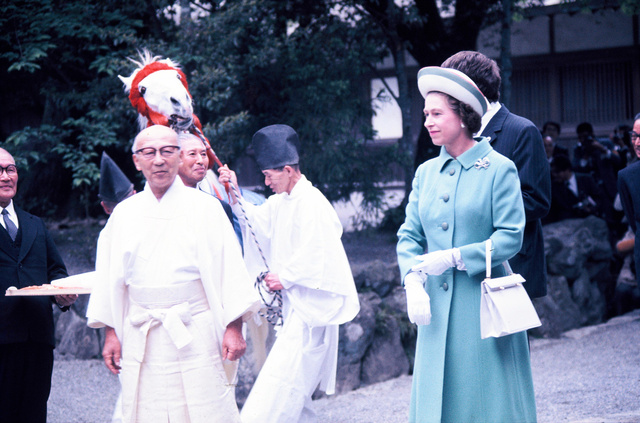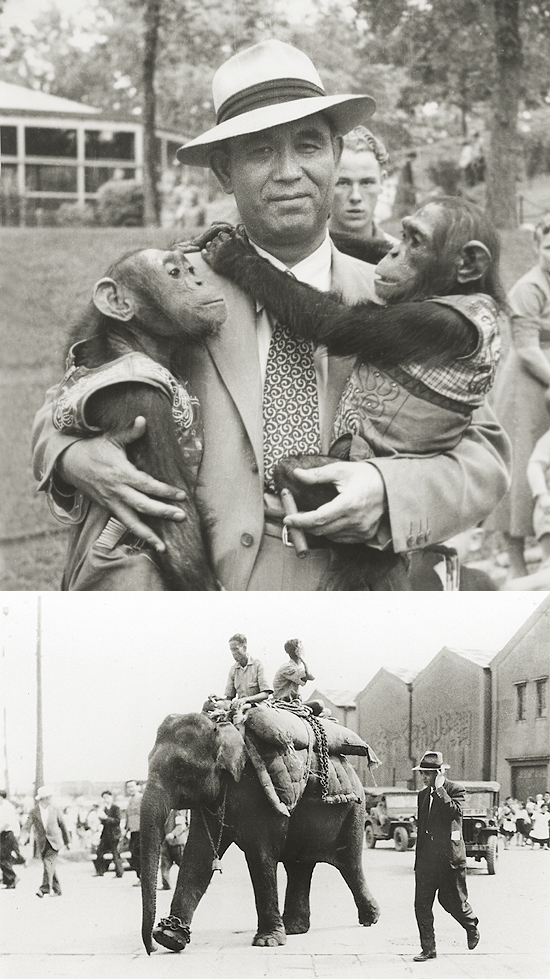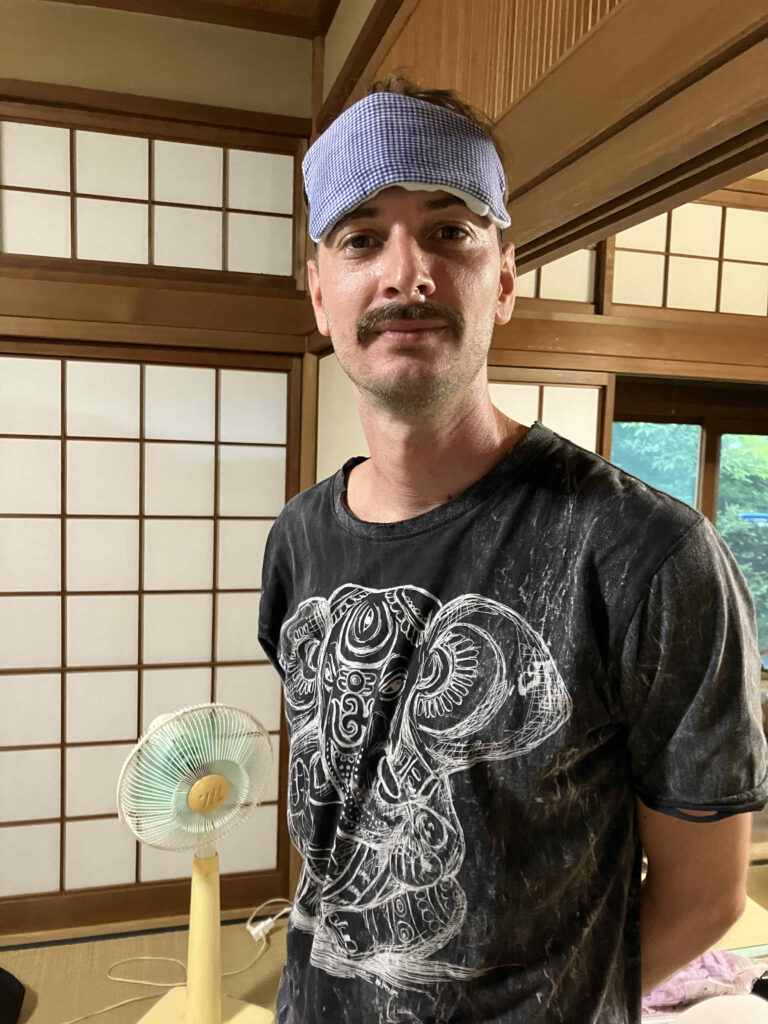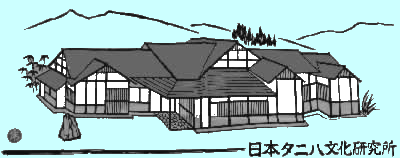日本タニハ文化研究所開設を応援された研究者 Researchers who supported the opening of Institute for Taniha Culture Research
はじめに
海外からの訪問者に合わせて急遽作成した。現在,玄関に掲げている三名の研究者を紹介する。ぼくも勉強にはなった。なお,本研究所の英名をタイトルのように変更した。
日本博物館協会関係
徳川宗敬 Tokugawa, Muneyoshi

左の写真: 昭和50(1975)年5月11日、伊勢神宮内宮を見学し、参道を歩いて戻るイギリスのエリザベス女王。左は徳川宗敬大宮司。三重県伊勢神宮。後背には内御厩(うちみまや)がみえる。朝日新聞デジタル
Photo 1: On May 11, 1975, Queen Elizabeth of the United Kingdom visited the Inner Shrine of Ise Grand Shrine. On the left, Chief Priest Muneyoshi Tokugawa can be seen.
宗敬は明治30(1897)年、水戸徳川家の12代当主の次男として生まれ、一橋徳川家の養子となった。大正9(1920)年に江戸幕府最後の将軍,徳川慶喜の孫に当たる幹子(もとこ)と結婚した。
東大農学部林学科を卒業した宗敬は同15年、幹子を連れて欧州へ留学する。2人は2年半の洋行で先進国の文化に触れる一方、第一次世界大戦の敗戦国となったドイツやオーストリアでは地位や財産を失った貴族の没落ぶりも目の当たりにした。
第二次世界大戦後、最後の貴族院副議長となった宗敬は、昭和26(1951)年のサンフランシスコ講和会議の全権委員、伊勢神宮大宮司などを務める。全国の植林運動にも尽力し、「緑化の父」とたたえられた。(三浦馨記す)
九十一歳(1989年)昇天。明治30(1897)年5月31日 – 平成元(1989)年5月1日。
url https://www.sankei.com/article/20191101-GDYF35IKYJNRNGUKESCGXVWZGY/
日本博物館協会の目的と沿革には,第二次世界大戦後の最初の会長(昭和21年)となったことが記されている。永く在任した。
Tokugawa Muneyoshi was born in 1897 (Meiji 30) as the second son of the 12th head of the Mito branch of the Tokugawa family, and was later adopted into the Hitotsubashi branch of the Tokugawa clan. In 1920 (Taishō 9), he married Motoko, granddaughter of Tokugawa Yoshinobu, the last shogun of the Edo bakufu.
Having graduated from the Department of Forestry in the Faculty of Agriculture at the University of Tokyo, Muneyoshi traveled to Europe in 1926 (Taishō 15) accompanied by his wife. During their two-and-a-half-year sojourn abroad, they were exposed to the cultures of advanced nations, while also witnessing firsthand the decline of the nobility in Germany and Austria, who had lost social standing and wealth as a result of their countries’ defeat in the First World War.
In the aftermath of the Second World War, Muneyoshi served as the last Vice President of the House of Peers, and in 1951 (Shōwa 26) he was appointed plenipotentiary to the San Francisco Peace Conference. He also held the post of High Priest of the Grand Shrine of Ise. Dedicating himself to nationwide afforestation campaigns, he was later acclaimed as the “Father of Greening.” (Recorded by Kaoru Miura)
He passed away at the age of ninety-one in 1989. (May 31, 1897 – May 1, 1989)
古賀忠道 Koga, Tadamichi

写真上:欧米視察,チンパンジーと(1951年)
写真下;日本に到着し、上野動物園に向かうインディラと古賀忠道園長(1949年、芝浦埠頭)
Photo 2 (1951): Inspection tour of Europe and America,holding chimpanzees.
Photo 3 (Shiba’ura Pier, 1949) : Indira and Director Tadamichi Koga heading to Ueno Zoo upon arrival in Japan.
明治36(1903)年12月4日佐賀県生。昭和3(1928)年東京帝国大学農学部獣医学科卒業と同時に東京市公園課に就職し,上野恩賜公園動物園に勤務。
昭和11(1936)年のクロヒョウ脱出事件を契機に、動物園に園長職がないことが見直され,翌1937年3月1日、園長制度がしかれ,正式な「動物園長」に就任。
戦後の昭和21(1946)年,映画館「かもしか座」の開設,1948年には子供動物園の開園,おサル電車の開通など,子どもたちへの明るい贈りものの開発に心をつくす。
昭和24(1949)年,インドのネール首相よりアジアゾウの「インディラ」が贈られ(Photo 3参照),1950年はインディラを中心とした移動動物園を実施する。Photo 2は,この翌年の欧米視察の際のもの。
昭和37(1962)年、創立80周年記念祭を最後に退職。退職後は、財団法人東京動物園協会理事長に就任するとともに,国際自然保護連合(IUCN)日本委員会の委員長をつとめ,ついで世界野生生物基金(WWF)日本委員会の設立に奔走した。
八十二歳(1986年)永眠。明治36(1903)年12月4日 – 昭和61(1986)年4月25日。
(2003年,上野動物園園長・菅谷博が展示によせたことばの抜粋,一部変更)
url https://www.tokyo-zoo.net/topic/topics_detail?kind=event&link_num=570
Tadamichi Koga was born in Saga Prefecture on December 4, 1903 (Meiji 36). In 1928 (Showa 3), upon graduating from the Department of Veterinary Medicine, Faculty of Agriculture, Tokyo Imperial University, he entered the Tokyo City Park Section and began his career at Ueno Zoological Gardens.
In 1936 (Showa 11), following the incident of a black panther’s escape, the absence of a formal directorship at the zoo was reconsidered. Consequently, on March 1, 1937, the office of “Director” was established, and he was formally appointed as the first Director of Ueno Zoological Gardens.
After World War II, in 1946 (Showa 21), he oversaw the opening of the “Kamoshika-za” cinema. In 1948, he initiated the founding of the Children’s Zoo, and soon after, the launch of the “Monkey Train,” dedicating his efforts to delivering cheerful experiences for children.
In 1949 (Showa 24), Prime Minister Jawaharlal Nehru of India presented the Asian elephant Indira to Japan (see Photo 3). In 1950, a traveling zoo was organized with Indira as its centerpiece. (Photo 2 shows him on his inspection tour of Europe and the United States the following year.)
In 1962 (Showa 37), after the celebration of the zoo’s 80th anniversary, he retired from his directorship. Following retirement, he became Chairman of the Tokyo Zoological Park Society and also served as Chairman of the Japan Committee of the International Union for Conservation of Nature (IUCN). He further devoted himself to the establishment of the World Wildlife Fund (WWF) Japan Committee.
He passed away in 1986 at the age of eighty-two (December 4, 1903 – April 25, 1986).
(Excerpted and slightly edited from the remarks contributed by Ueno Zoo Director Hiroshi Sugaya, 2003.)
王仁三郎関係
上田正昭 Uyeda, Masa’aki
王仁三郎の神懸かりがあった産土神社である小幡神社宮司である。父は学者としての氏を信頼していた。父の計らいで小幡神社(上田先生斎主)でぼくたちは結婚式を挙げている。ネット上の写真にはいいものがない。結婚式の際に父が沢山写真を撮ってくれた。ぼくのアルバムを探せば出てくるのだろう。
福岡アジア文化賞受賞(1998年)の際の紹介文を次に引用するが繰り返しがひどくて簡略化している。
上田正昭は,日本古代史を東アジア世界の歴史の動向と連動させて解明した。アジアの中の日本という新たな歴史像を構築したことで,国際的にも高い評価を得ている。
『日本の神話を考える』では,中国大陸や朝鮮半島の神話との比較研究を行い,歴史学・民俗学・考古学との学際的研究を通じて日本神話を追求した。中国や朝鮮からの渡来文化の影響や実態,あるいは,アジア・太平洋につながる海上の道の重要性に注目し、アジアの中の日本という新しい地域史を構築した。
1990年には,東アジア古代史では初めての国際学会「アジア史学会」を創設し,1996年の第6回北京大会では,会長に就任している。
八十八歳(2016)昇天。昭和2(1927)年4月29日- 平成28(2016)年3月13日。
url https://fukuoka-prize.org/laureates/detail/bd0b26ed-96c8-47b0-9bb5-04d307d698f5
兵庫県城崎町生。養子先の小幡神社宮司の神職になるべく戦時中,國學院大学専門部に入学し,折口信夫(おりくちしのぶ)らの指導を受け,戦後,京都大学文学部に進学している。
Masa’aki Uyeda served as the chief priest of Obata Shrine, the tutelary shrine where Onisaburō Deguchi, one of two Founders of Ōmoto-kyō, experienced his divine inspiration. My father, Tsugimori Koba, trusted him for his scholarly integrity. It was through Tsugimori’s arrangement that Fumiko and me held our wedding ceremony at Obata Shrine, officiated by Reverend Masa’aki Uyeda. Unfortunately, there are no good photographs available online; however, during the ceremony Tsugimori took many pictures, which will surely be found if I search through my album.
The following is a citation from the introduction provided upon his receipt of the Fukuoka Asian Culture Prize in 1998. The original text contained considerable repetition, which has here been reduced for clarity.
Masa’aki Uyeda illuminated the history of ancient Japan in the broader context of East Asian historical developments. His achievement lay in constructing a new historical perspective—Japan within Asia—for which he has received international acclaim.
In his work “Considering the Myths of Japan”,『日本の神話を考える』, he pursued comparative studies of Japanese mythology alongside those of China and the Korean Peninsula. Through interdisciplinary research that integrated history, folklore, and archaeology, he explored the formation and character of Japanese myths. He emphasized the significance of cultural influences from the Chinese continent and the Korean Peninsula, as well as the role of maritime routes linking Japan with the wider Asia-Pacific. From this perspective, he constructed an entirely new regional history in which Japan is situated as part of Asia.
In 1990, he founded the Society of Asian Studies, the first international academic association devoted to East Asian antiquity. At its sixth meeting, held in Beijing in 1996, he was appointed as president.
He passed away in 2016 at the age of eighty-eight. Born on April 29, 1927, in Kinosaki, Hyōgo Prefecture, he entered the Specialized Division of Kokugaku’in University during the war years in order to prepare for succession to the priesthood of Obata Shrine, into which he had been adopted. There he studied under such scholars as Shinobu Orikuchi. After the war, he advanced to the Faculty of Letters at Kyoto University.
Young guest from Belgique

The young man in Photo 4 is a researcher from Belgium. He mainly observes the realities of religion in various Southeast Asian countries. He was brought here by my niece. His specialties are psychology and philosophy. The thing on his head is an ice pack that I gave him. It was really hot Yesterday, but being at the foot of the mountain meant we sometimes got a cool breeze—along with the mosquitoes. He’s a genuinely nice guy with good character.
Written on the next day, Aug. 18, 2025.
以 上

